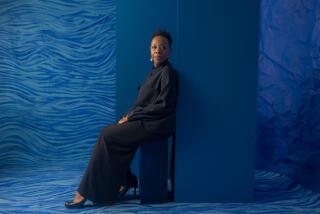Review: ‘Togetherness’ shows real life’s just funny that way
Brothers Mark and Jay Duplass, who have made many movies together as writers, directors and actors — including “The Puffy Chair,” “Jeff, Who Lives at Home” and “The Do-Deca-Pentathlon” — have a TV series now. It’s called “Togetherness” and premieres Sunday on HBO. It is a lovely, melancholic comedy about adults, for adults.
Elsewhere on television, Mark is one of the stars of “The League”; Jay plays Jeffrey Tambor’s son on “Transparent”; and together they play the midwives in the office upstairs on “The Mindy Show.” Jay, who co-wrote and co-directed with Mark, stays behind the camera here.
Mark plays Brett, who is married to Michelle (Melanie Lynskey); they have two young children and a stable but marginally unsatisfying life. Michelle, who feels the weight of routine, longs for something unexpected; Mark, who loves his work but not his job — he is a creatively frustrated, mid-level sound designer for film and the family’s sole support — seeks refuge in the familiar.
Into their Eagle Rock Craftsman house comes Brett’s best friend, Alex (Steve Zissis, who co-wrote the story), a little-employed actor “too fat for the leading man roles and too skinny to be the chubby best friend,” who has just been evicted from his apartment. He is followed shortly by Michelle’s sister, Tina (Amanda Peet), visiting from Houston, who decides to stay after a breakup. Each is a hot mess, but not merely a hot mess. And that is just enough new stress to set things tumbling.
Like Mike White’s “Enlightened” and Lena Dunham’s “Girls,” also on HBO, and Jill Soloway’s “Transparent” on Amazon, the series transfers to the no-longer-quite-so-small screen the concerns and aesthetics of independent film, particularly the style called “mumblecore,” with its focus on character, naturalistic dialogue and subdued, often indefinite plotting.
As the name might imply, the difficulty of communication between individuals — indeed, the near-impossibility of ever really saying what one means, when meaning itself is so endlessly mutable — characterizes the genre both in content and form. Awkwardness, and the likelihood of whatever one says being the wrong thing, is its anxious resting state.
Much writing for television (and film) might be characterized as Newtonian — there is a cause for every effect, things move relentlessly forward. Plots can seem reverse-engineered, in order to bring things to a certain end, or cliffhanger; characters change to accommodate the needs of the story, not from any internal, organic logic.
What’s going on here, and in the shows noted above, is something more lifelike, something that might be called a quantum comedy, couched in ambiguities and spooky entanglements, where action meets inaction, indecision amounts to decision and what feels like clear-sightedness is just a new kind of confusion. To stay together or not to break up; to move on or not to stay still; to be or not to not be?
Though certain passages and conceits do have the feel of being “of the movies” or of TV — that Brett and Michelle are not having sex is an overworked dilemma nowadays, and there are some fanciful characters and a few rom-com tropes ahead — what is happening on screen at any moment has a ring of truth; there’s a life in it. None of the characters gets everything right, or nothing right.
Much of this depends on the actors, of course, who make their characters vivid without any sacrifice of subtlety. Peet, whose Tina is unhappily single on the edge of 40, reminds you of just how good and adaptable an actress she is. Lynskey, who plays next-door-stalker Rose on “Two and a Half Men” but also has a long history in independent film, is all deep waters and live wires; soft and steely, trying on new personas for size, her Michelle becomes the series’ gravitational center. You can feel her feeling.
Duplass is sympathetic as a man surprised both by his dissatisfaction and the stiffness he’s acquired to maintain it; and Zissis — to whom more conventional films or shows would relegate to character parts, or make pathetic, as he grows more interested in Tina — turns in a performance of great, if often clownish, dignity.
They’re accompanied by Peter Gallagher, who starred in the proto-mumblecore movie “Sex, Lies and Videotape,” as a Hollywood producer in whom Alex and Tina are differently interested; John Ortiz as a neighbor who attracts Michelle’s half-moony attention; and Mary Steenburgen, that most valuable utility player, as a sort of Griffith Park shaman Brett will encounter.
Like “Enlightened” and other indie-aesthetic series, “Togetherness” is “cinematic” not in the sense of seeming “bigger than life” or obviously expensive; rather, it feels big the way life itself sometimes does, when all one’s senses are clicking, that state of wakeful dreaming that movies at their best can encourage.
There are a few marvelous set pieces in “Togetherness” — party scenes, a game of kick the can, a dance-driven sequence in a cowboy bar — but even when nothing particular is happening, it feels like life.
Twitter: @LATimesTVLloyd
---------------------------
‘Togetherness’
Where: HBO
When: 9:30 p.m. Sunday
Rating: TV-MA (may be unsuitable for children under the age of 17)
More to Read
The complete guide to home viewing
Get Screen Gab for everything about the TV shows and streaming movies everyone’s talking about.
You may occasionally receive promotional content from the Los Angeles Times.







